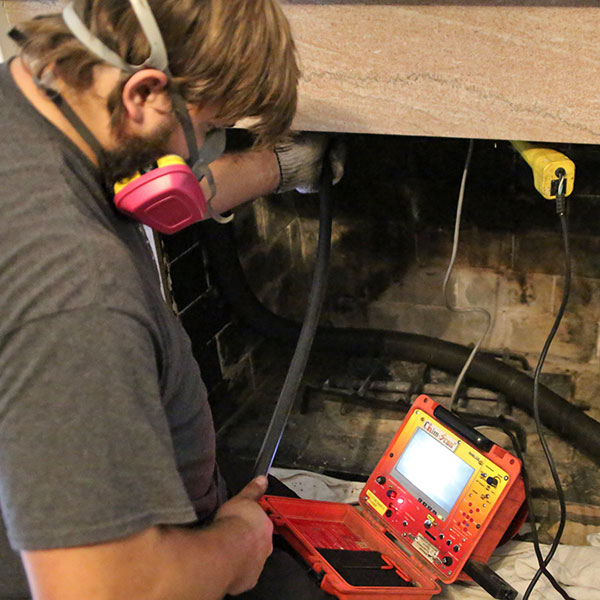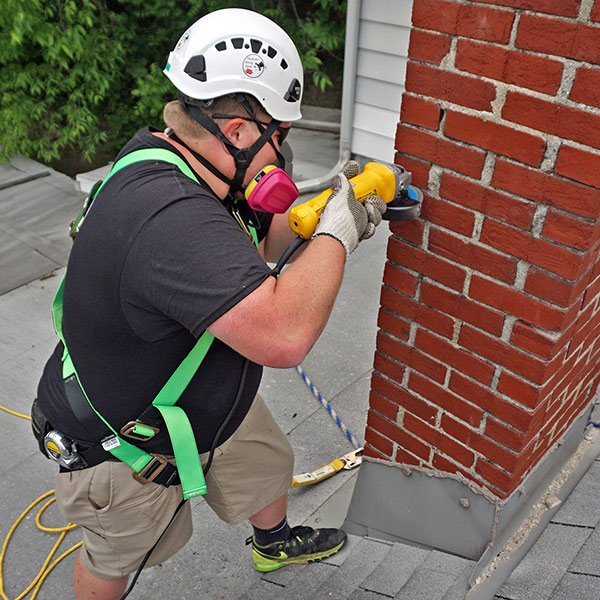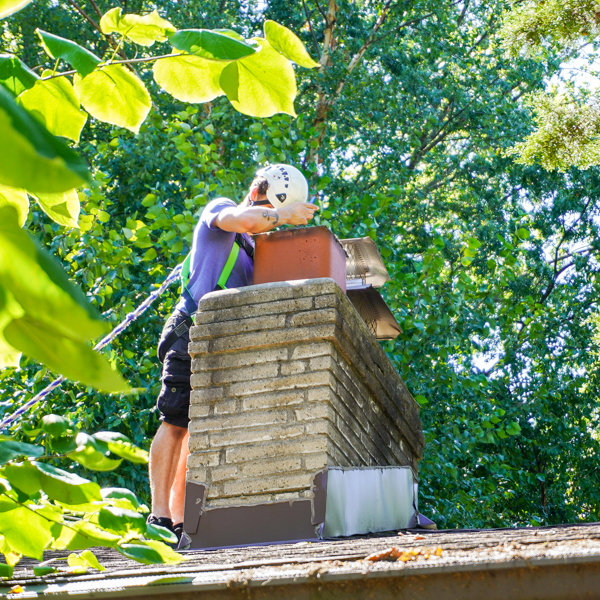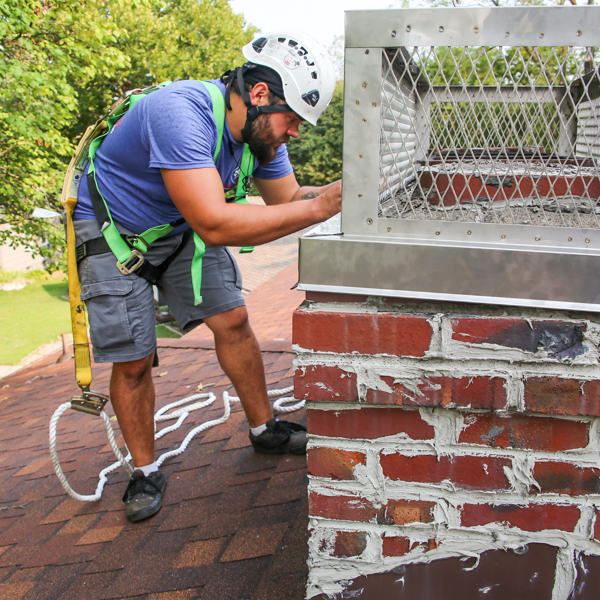4 Signs that You Need Chimney Repair
Chimneys last for many years, but they don’t last forever. Various things can go wrong with them over time. As a homeowner, you want to catch problems early and get them fixed quickly. Here are some things to look for that tell you your chimney needs attention.
Smoke drafting problems
 If smoke is backing up into your home, your biggest concern is the carbon monoxide that smoke carries. Carbon monoxide is invisible and odorless, but it is known to be potentially fatal to people and pets when inhaled.
If smoke is backing up into your home, your biggest concern is the carbon monoxide that smoke carries. Carbon monoxide is invisible and odorless, but it is known to be potentially fatal to people and pets when inhaled.
Drafting problems can be simple or complicated, depending on the cause.
The most common reasons for smoke to not draft properly up a chimney include:
- Obstructions such as built-up creosote or outside debris including leaves, twigs and the nests of small animals
- Fireplace damper not completely open
- House too air-tight (cracking a window usually solves this)
- Negative air pressure in the home caused by kitchen or bathroom fans, clothes dryers or other blowing devices
If you try everything and can’t solve the problem on your own, contact a licensed chimney inspector to determine if there are blockages in your flue.
Cracked or crumbling masonry
 Even the smallest cracks in your chimney bricks can lead to big trouble down the line. The same with mortar that’s crumbling. When water penetrates masonry, it can begin a cycle of deterioration. If the moisture freezes in cold weather, it will expand and cause more masonry damage.
Even the smallest cracks in your chimney bricks can lead to big trouble down the line. The same with mortar that’s crumbling. When water penetrates masonry, it can begin a cycle of deterioration. If the moisture freezes in cold weather, it will expand and cause more masonry damage.
It’s a good idea to perform periodic visual inspections of your exterior chimney and look for areas that are cracked and crumbling. Masonry problems don’t resolve themselves, rather they get worse until you could be facing a collapsed chimney.
Chimney technicians have a variety of ways to address masonry damage. They can replace crumbling mortar and cracked bricks. They can rebuild sections of the chimney as needed. As a preventative, they can apply a water sealant to the chimney’s surfaces.
Component damage
Along with occasional visual inspections of your chimney’s masonry, you should take a look at its components.
- Make sure your chimney cap is fitted securely and isn’t warped, broken or otherwise damaged.
- Check the concrete chimney crown for signs of cracking and crumbling.
- Look at the flashing that seals the gap between the roof and chimney. Is it warped or rusted? Are sections missing?
- How does your fireplace damper work? Is it smooth, or is it hard to move and squeaky?
Any component issues you uncover can be resolved by a chimney technician either through repair work or component replacement.
Leaky chimney
Chimney leaks should be determined and repaired as quickly as possible to prevent widespread structural and component damage. A severely leaking chimney also can cause rot and decay in home building materials near the leak.
Look for these signs of a leaky chimney:
- Water in the firebox
- Strong musty odors coming from the fireplace or in the attic or crawl spaces
- Damp sections of the ceiling or walls near the fireplace/chimney
- White discoloration (efflorescence) on the exterior chimney masonry
Contact a chimney repair company if you notice any of these signs.
Keep your chimney in great shape all year long
Fluesbrothers Chimney & Fireplace of Kansas City, KS, is ready to help with all your chimney needs including chimney cleaning, chimney inspections and a full menu of repair and rebuilding services.
To arrange an appointment or get your questions answered, call (913) 236-7141.
The post 4 Signs that You Need Chimney Repair appeared first on Fluesbrothers Chimney Service.
 What a chimney inspector does
What a chimney inspector does Chimney cap, crown and flashing damage
Chimney cap, crown and flashing damage Tip #1 – Schedule A Chimney Inspection
Tip #1 – Schedule A Chimney Inspection

 The purpose of a chimney is to draw smoke and toxic gases up and out of a home. If the flue becomes blocked by animal nests, residue from smoke (called creosote), broken masonry, dead animals, etc. The smoke and toxic fumes have nowhere to go except back into your home. This can lead to carbon monoxide poisoning. Carbon monoxide is an invisible and odorless gas so you won’t notice it until it is too late. Symptoms of carbon monoxide poisoning are confusion, headaches, difficulty breathing, nausea, loss of consciousness and even death.
The purpose of a chimney is to draw smoke and toxic gases up and out of a home. If the flue becomes blocked by animal nests, residue from smoke (called creosote), broken masonry, dead animals, etc. The smoke and toxic fumes have nowhere to go except back into your home. This can lead to carbon monoxide poisoning. Carbon monoxide is an invisible and odorless gas so you won’t notice it until it is too late. Symptoms of carbon monoxide poisoning are confusion, headaches, difficulty breathing, nausea, loss of consciousness and even death. Masonry can become cracked for a variety of reasons. The first is the changing weather, over time the brickwork will begin to crack and even crumble due to the cycle of freezing and thawing. Heavy winds and water damage can lead to large cracks.
Masonry can become cracked for a variety of reasons. The first is the changing weather, over time the brickwork will begin to crack and even crumble due to the cycle of freezing and thawing. Heavy winds and water damage can lead to large cracks. Put away your knickknacks.
Put away your knickknacks. Our chimney sweeps are
Our chimney sweeps are  The crown of a chimney is just as important as it sounds. The crown surrounds the top of the chimney and serves as an umbrella for the whole structure. Besides being a finishing touch, the crown protects your chimney from the eroding effects of water. A
The crown of a chimney is just as important as it sounds. The crown surrounds the top of the chimney and serves as an umbrella for the whole structure. Besides being a finishing touch, the crown protects your chimney from the eroding effects of water. A  This can point to excess age or water damage. Though bricks are notoriously durable they can deteriorate over time, leaving your chimney susceptible to all the hazards we mentioned, animals, water damage and eventual collapse.
This can point to excess age or water damage. Though bricks are notoriously durable they can deteriorate over time, leaving your chimney susceptible to all the hazards we mentioned, animals, water damage and eventual collapse. The weather is getting cooler and the Christmas decorations are out. There’s no doubt that firewood will be chopped for lighting up the fireplace this season. The most important thing is to have a
The weather is getting cooler and the Christmas decorations are out. There’s no doubt that firewood will be chopped for lighting up the fireplace this season. The most important thing is to have a  Many fires occur because of ashes being dumped in dangerous ways. The safest way to get rid of ashes is to make sure they are properly cooled and then placed in a fireproof container with a lid. The best practice is to keep this container away from anything flammable including wood or linen and at a distance of at least 10 feet from your home or other buildings.
Many fires occur because of ashes being dumped in dangerous ways. The safest way to get rid of ashes is to make sure they are properly cooled and then placed in a fireproof container with a lid. The best practice is to keep this container away from anything flammable including wood or linen and at a distance of at least 10 feet from your home or other buildings. The freeze and thaw effect.
The freeze and thaw effect. Leaks, mildew, and mold
Leaks, mildew, and mold Once the decision is made to
Once the decision is made to  Get The Gas Fireplace Logs Cleaned
Get The Gas Fireplace Logs Cleaned